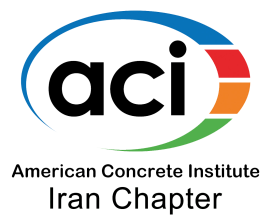آیین نامه مسابقات بین المللی دانشجویی بتن شاخه های منطقه¬ای (ACI)
ACI IRAN CHAPTER
ECOCONCRETE STUDENT COMPETITION 2023
مسابقه بتن سازگار با محیط زیست
5 و 6 دی ماه ۱۴۰2
دانلود آئین نامه دانلود فرم ثبت نام

بیست و ششمین همایش سالیانه انجمن بین المللی بتن (ACI) – شاخه ایران
5 و 6 دی ماه 1402
با همکاری وزارت علوم، تحقیقات و فناوری
مجری:
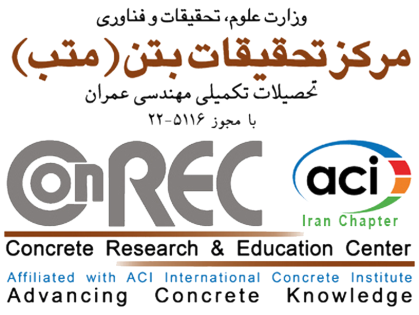
علاقمندان می توانند جهت ثبت نام و کسب اطلاعات بیشتر به پایگاه اینترنتی
www.aciiranchapter.org مراجعه کرده و یا با شماره تلفن 88664151 تماس حاصل نمایند.
دانشجویان علاوه بر سایت های انجمن می توانند تمامی آئین نامه های مسابقات دانشجویی و فرم ثبت نام را از کانال تلگرام انجمن دانلود نمایند.![]()
ACI Iran Chapter ECO Concrete Competition
1. OBJECTIVES AND PRIZES
1.1 Objectives
In order to contribute to and educate the future generation of civil engineers on the sustainable development of concrete, this student competition aims to promote the idea of environmental performance in concrete mix designs. Teams thus have the mission to develop an innovative concrete mixture, which will have the lowest possible environmental impacts while maintaining or improving the durability performance. To achieve this goal, teams are encouraged to seek out and use local resources of ecofriendly materials such as supplementary cementitious materials (SCMs).
After designing their concrete mixture, teams are asked to perform a simplified life-cycle assessment (LCA) and present their results in a written report and a recorded presentation. The format of this report is inspired by an environmental product declaration document, which is favored by the industry to communicate the environmental footprint of products.
In addition to the report, teams shall prepare the simulation results of their mixtures using the Life 365TM software. This open-source tool has been extensively used by concrete designers and engineers to predict the durability performance of concrete against chloride attacks. In this competition, teams will also have to present a recorded video on their concrete mix designs to the judges, with an emphasis on the environmental aspect considered in their decision.
برای دریافت نسخه PDF آیین نامه مسابقه بتن سازگار با محیط زیست اینجا کلیک کنید.
مشاهده ادامه آیین نامه
1.2 Prizes
The durability performance improvement, quality of the report and recorded presentation as well as answering judges’ question during an online interview, and environmental score from the simplified life-cycle assessment will be the parameters in determining the winners. First, Second, and Third place entries will each be awarded a certificate of recognition, will be recognized in ACI Iran Chapter’s newsletter if space allows, and will be recognized on ACI’s Iran Chapter website at www.aciiranchapter.org.
The Eco Concrete Competition: Lessons learned by (and from) students
2. RULES
2.1 Eligibility
- Each team must consist of students in high school, technical school, trade school, or undergraduate students at a college or university at the time of the competition. Undergraduate students on cooperative or internship work assignments are also eligible to participate. All members of a team must be from the same school.
- Each team can get help from one graduate student to participate in designing the mixtures and running the simplified life-cycle assessment (LCA), though the student shall be mentioned in the report.
- A team is limited to eight individuals and a school may register only one team.
- Each team must have a supervising faculty advisor who will oversee the compliance of the student mix designs, calculations, and report with the rules of the competition.
- Since this competition involves an online interview, it is required that the team members join the preset time schedule for answering judges’ questions.
- Registration dates are listed at the end of these rules. Teams will receive confirmation of registration from ACI and must be sure to submit all required paperwork and information by the deadlines noted.
- The rules of eligibility have been translated to Persian and attached to this document. See attachment A.
2.2 Materials
All materials and mix design(s) used for the competition have to be clearly described in the written report and the recorded video (see Section 2.3). Material requirements indicated below should be closely followed, as teams failing to do so will be penalized, possibly with disqualification from the competition.
a. Portland cement Type I or II satisfying ASTM C150 or hydraulic cement GU type complying with ASTM C1157 must be used. Commercial blended cement is not allowed.
b. Supplementary cementitious materials (SCM), such as fly ash, silica fume, and/or slag cement, can be incorporated into the concrete mixtures but as separate products from the portland cement.
2.3 Concrete mix design
Mix design requirements indicated below shall be closely followed for both mixtures, as teams failing to do so will be penalized, possibly with disqualification from the competition.
– Water-to-binder ratio
i. The water-to-binder ratio (by mass) is fixed to 0.40. The binder shall include all types of portland or hydraulic cement specified in section 2.2.a and SCMs, as identified in section 2.2, that are used in the mix.
– Aggregate proportioning
i. The aggregate(s) shall constitute a minimum of 75% of the total mass of concrete mixtures (therefore, the total mass proportion of paste in concrete is 25% or less). This percentage shall be calculated based on a comparison of the total mass of all aggregates in surface saturated dry (SSD) condition, to the total mass of the concrete (based on yielded proportions). The contribution of coarse aggregates (aggregates with a minimum size of 5 mm) mass must be more than 30% of the mass of the total aggregate.
2.4 Simplified Life Cycle Assessment
Each team must prepare a simplified LCA using the EcoConcrete Calculation Tool V2.01, following the specifications listed below. This simplified LCA calculates the environmental impacts of mixtures. For each process, five environmental impact categories, namely global warming, carcinogenic, ozone depletion, ecotoxicity, and fossil fuel depletion, are computed. The average reduction in the value of these five categories is considered to form the Single Score Ratio. More information on this approach is provided in the “EcoConcrete calculation tool instruction” document provided on the competition website.
a. Goal and Scope
The objective of this competition is to design a concrete mix using alternative materials with low environmental impacts while improving durability performance.
b. Functional Unit
The functional unit is the production of one cubic meter of concrete mixture complying with the rules mentioned in sections 2.2 and 2.3.
c. System Boundaries
The system boundaries analyzed, in compliance with the ready-mix concrete supply chain, including the extraction of the raw materials to the production of one cubic meter of ready- mix concrete (See Figure 1). Each team shall comply their Simplified LCA scope with the following system boundaries for a cradle to gate analysis.
i- Extraction of raw materials and transportation to the plant.
ii- Materials processing at the plant.
iii- Transportation of the processed and raw materials from the plant or site to the batching plant (your school location).
Figure 1: Schematic representation of system boundaries
The following shall not be included in the simplified LCA:
iv. Production of concrete at batching plant (your school location).
v. Manufacturing and maintenance.
vi. Demolition and end-of-life.
d. Inventory (To be completed in the EcoConcrete Calculation Tool V2.01)
i. Each team shall consider the electrical and/or thermal energy required for producing (transform) each material used as a concrete mixture ingredient. The appropriate energy mix of the region must be selected in the EcoConcrete Calculation Tool V2.01 to represent their local production emissions.
ii. Transport of each material should be considered. The batching plant shall be the location of your school lab.
Each team shall provide a travel map demonstrating the transportation path of each input material. Each transportation impact should be listed in the calculation table provided in the EcoConcrete Calculation Tool V2.01.
Each team must design two concrete mixtures using the corresponding worksheets in the EcoConcrete Calculation Tool V2.01: (1) Base-Case Scenario (BCS) and (2) an Alternative- Case Scenario (ACS). Both scenarios must respect the criteria presented in sections 2.2 and 2.3.
2.4.1 Designing Base-Case Scenario and Alternative-Case Scenario
a. Designing the Base-Case Scenario (BCS) concrete mixtures.
i. BCS cementitious binder must be designed with 100% portland or hydraulic cement specified in section 2.2.a.
b. Designing the Alternative-Case Scenario (ACS) concrete mixtures.
i. A maximum of 40% of the mass of the binder materials can be replaced by non-portland cement material (e.g., SCMs).
ii. ACS must be designed with the same total volume of cementitious materials (binder) as the BCS mixture (in kg/m3).
iii. ACS must be designed with the same volume of the total fine and coarse aggregates as the BCS mixture (for example, if 80% of the BCS mixture volume consists of aggregates, the same 80% volume shall be incorporated for the ACS mixture considering the difference in the density of the aggregates used in the ACS and BCS).
IMPORTANT NOTE: All the inputs in the tool, such as materials, transportation distances, and the processing energy, must be based on the real case and shall be explicitly presented in the report and recorded presentation. In addition, all the identical materials in ACS and BCS (e.g., portland cement and virgin aggregates) shall be supplied from the same source or plant.
After computing the environmental single score (SS) of each scenario (by the EcoConcrete Calculation Tool V2.01), the SS ratio is calculated, as presented in Equation 1, to highlight the relative environmental improvements from the base case to the alternative mix. A minimum 15% improvement in the environmental impact score is required for this competition.

Such scenarios will allow comparing relative environmental improvement of each team and avoiding geographical distortion
2.4.2 Calculating environmental impacts with the EcoConcrete Calculation Tool V2.01
The EcoConcrete Calculation Tool V2.01 provides a simple way for students to calculate and compare the environmental impacts of the ACS and BCS concrete mixtures. The instructions for using this tool are provided in the “EcoConcrete calculation tool instruction” document provided on the competition website.
2.5 Service life prediction in Life-365TM
Students shall simulate the service life of the ACS and BCS mixtures for the marine environment located in the state of Florida, where the chloride attack is the dominant determining factor for the durability of concrete structures. The durability of BCS and ACS mixtures against rebar corrosion shall be simulated using the Life-365TM software v2.2.3. This software has been widely used in the concrete industry can be great training for students to learn how the concrete mix design parameters can affect the chloride penetration rate in concrete. The software is available for download on Windows and iMac platforms from the following link:
http://www.life-365.org/download.html
Teams are encouraged to read the manual before and after the software installation. Nevertheless, the rules regarding the software default inputs for the exposure conditions and materials properties are provided in this section. For a consistent exposure condition, parameters other than the mix designs are set consistently among the participant teams. It is highly recommended to choose the SI system for the software input units right after the installation to accurately enter the specified inputs.
Teams shall model their ACS and BCS mixtures, save the output file (JSON file) and submit the file along with other requested documents (calculation tool including the mix designs and calculated environment impacts, report, and recorded presentation).
The instruction for the simulation in Life-365TM software starts from creating a new project from the navigation menu. After creating the project, a new window with several tabs will appear on the screen.
i. Under the first tab, “Project” (See Figure 2):
– In the “Identify Project” section, the “Title” cell shall be filled with the team’s name and in the “Analyst” cell, teams shall provide all the team members’ names and last names. Filling other cells such as the date and description is not mandatory.
– Under the “Select Structure Type and Dimensions” section, the type of structure shall be set as “slabs and walls (1-D)” from the dropdown menu; The “Thickness”, “Reinf. depth”, and “Area” cells shall be entered as 200 mm, 50 mm, and 5 m2 , respectively. Therefore, the total volume of concrete shown in that section is 1 m3 . The “Chloride concentration units” shall be set as “% wt. conc”.
– Under the “Define Economic Parameters”, the “Base year” and “Analysis period” values shall be set to 2020 and 100, respectively.
-Under the “Define Alternatives (up to 6)” section, by double-clicking on the cells, the name of mixtures shall be set to “BCS” and “ACS”.

Figure 2: Overview of the “Project” tab in Life Life-365TM software
ii. After verifying the inputs with teammates, students will define the inputs in the second tab “Exposure” (See Figure 3):
-Under the “Select Method for Setting External Concentration and Temperature Profile” section, the “Use defaults” shall be set, and the “Location”, “Sub-location” and “Exposure” shall be set to “Florida”, “TAMPA”, and “Marine spray zone”, respectively. No other inputs shall be changed in this Tab.

Figure 3: Overview of the “Exposure” tab in Life Life-365TM software


Figure 4: Overview of the “Concrete Mixtures” tab in Life Life-365TM software
No other inputs are required for the service life simulation. After clicking on the “Calculate service life” button at the top of the window, the bar charts will appear showing the initiation and propagation years for the BCS and ACS mixtures. The relative service of life of ACS/BCS shall be calculated according to the simulation results and shall be reported in the written report summary and presentation. After finishing the service life modeling, the JSON file shall be saved and included in the document submission.
a. Scoring
Teams will be ranked on the relative improvement in the service life of their mixtures, showing that how much increase in the service life was obtained using the ACS compared to the BCS mixtures. The durability performance score is obtained by the division of ACS/BCS “propagation service lives” (values corresponding to the top of the grey bar charts shown in Figure 4). Teams with the largest improvement in service life will obtain the first rank and a score of 100. Other teams will be awarded scores of an evenly graduated decrease according to the total number of teams.
2.6 Written Report
Teams shall submit a written report meeting the requirements listed below for the judges to review and score. An electronic version of the report shall be submitted as described below in standard PDF format. The electronic report due date is indicated in Section 6 below. Teams failing to submit the electronic version of the report shall receive a zero score in the written report section of the Final Score equation provided in Section 3.
Judges will score each report using the indicated scoring percentages (based on a total of 100%). Each report shall contain the following (see the scoring sheet for more details):


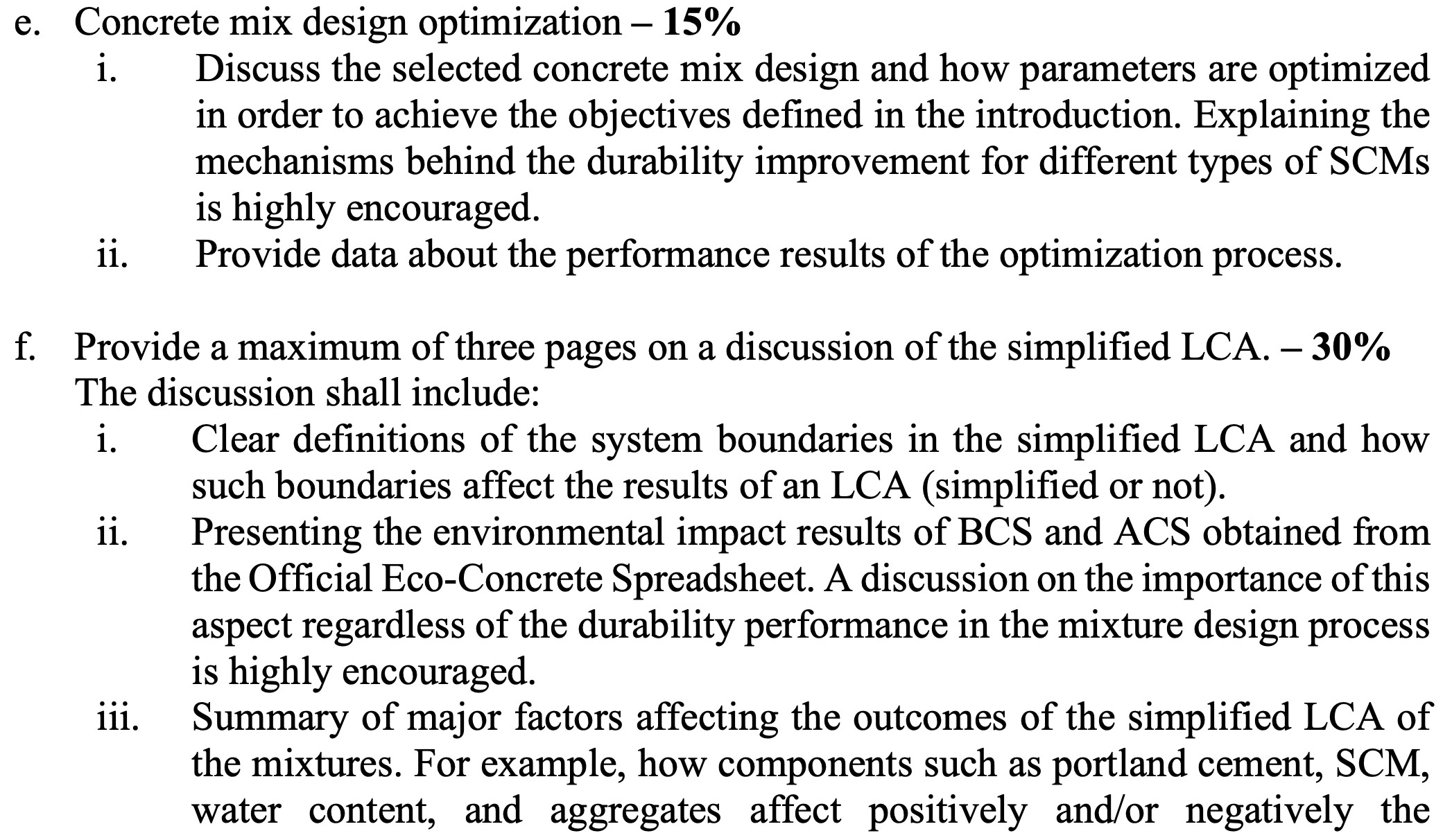
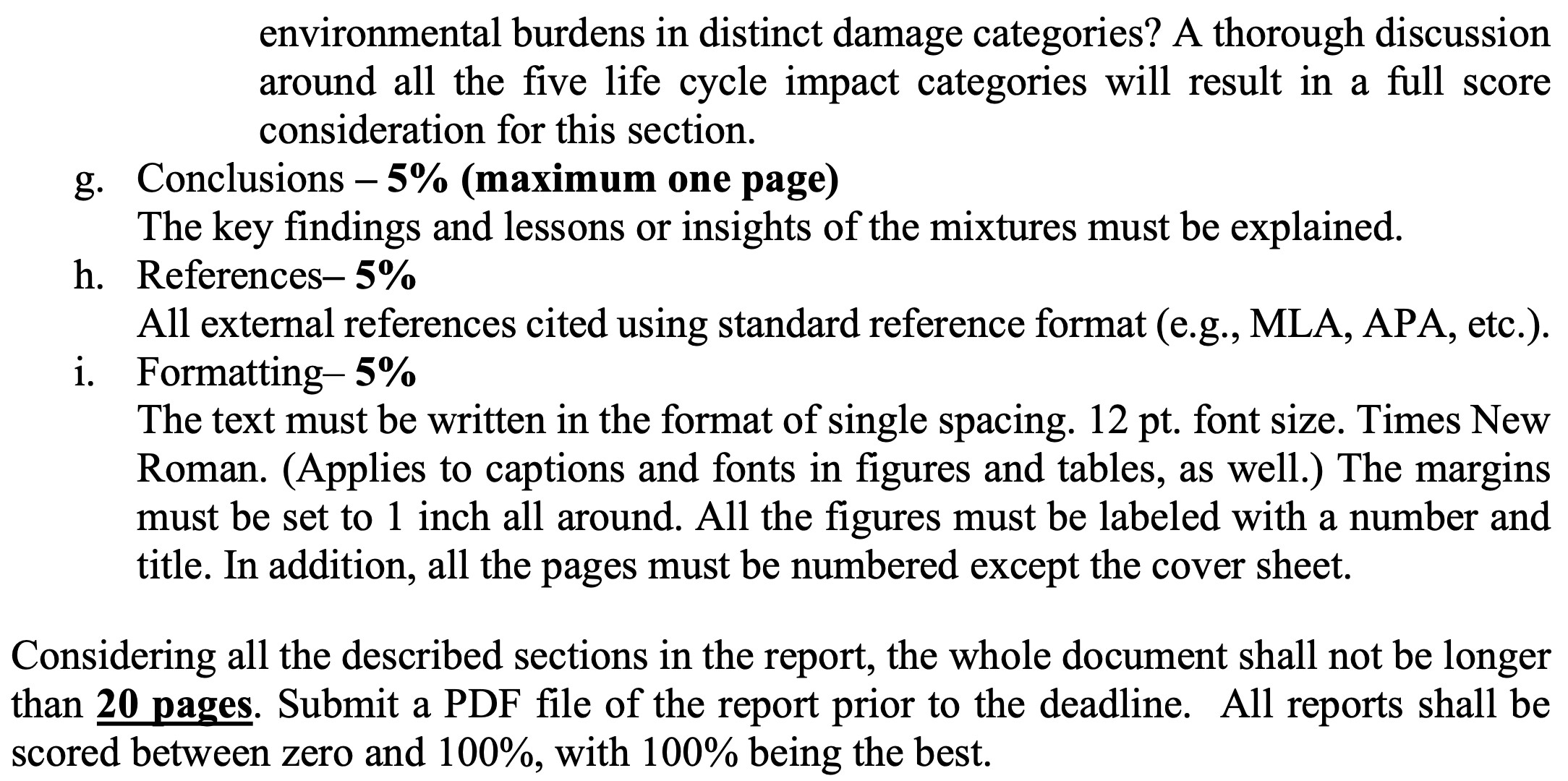
2.7 Recorded video
Teams must make a recorded video prepared in the English language. The recording must meet the requirements listed below for the judges to review and score.
Submission consisting of a YouTube video URL, no longer than 7 minutes, meeting the requirements specified below, shall be submitted through the competition webpage prior to 5:00 p.m. on 6 December 2022. The YouTube video settings must be public, and the “Made for Kids” option must be turned off. The YouTube video should be uploaded in the following format:
a. Title: TEAM NAME – ECOCONCRETE
b. Description: Include the Team Name, University Name, and a brief description of the solution presented in the video.
Content should be understood by an English-speaking audience. Ethical and professional responsibility stated elsewhere in these rules must be followed.


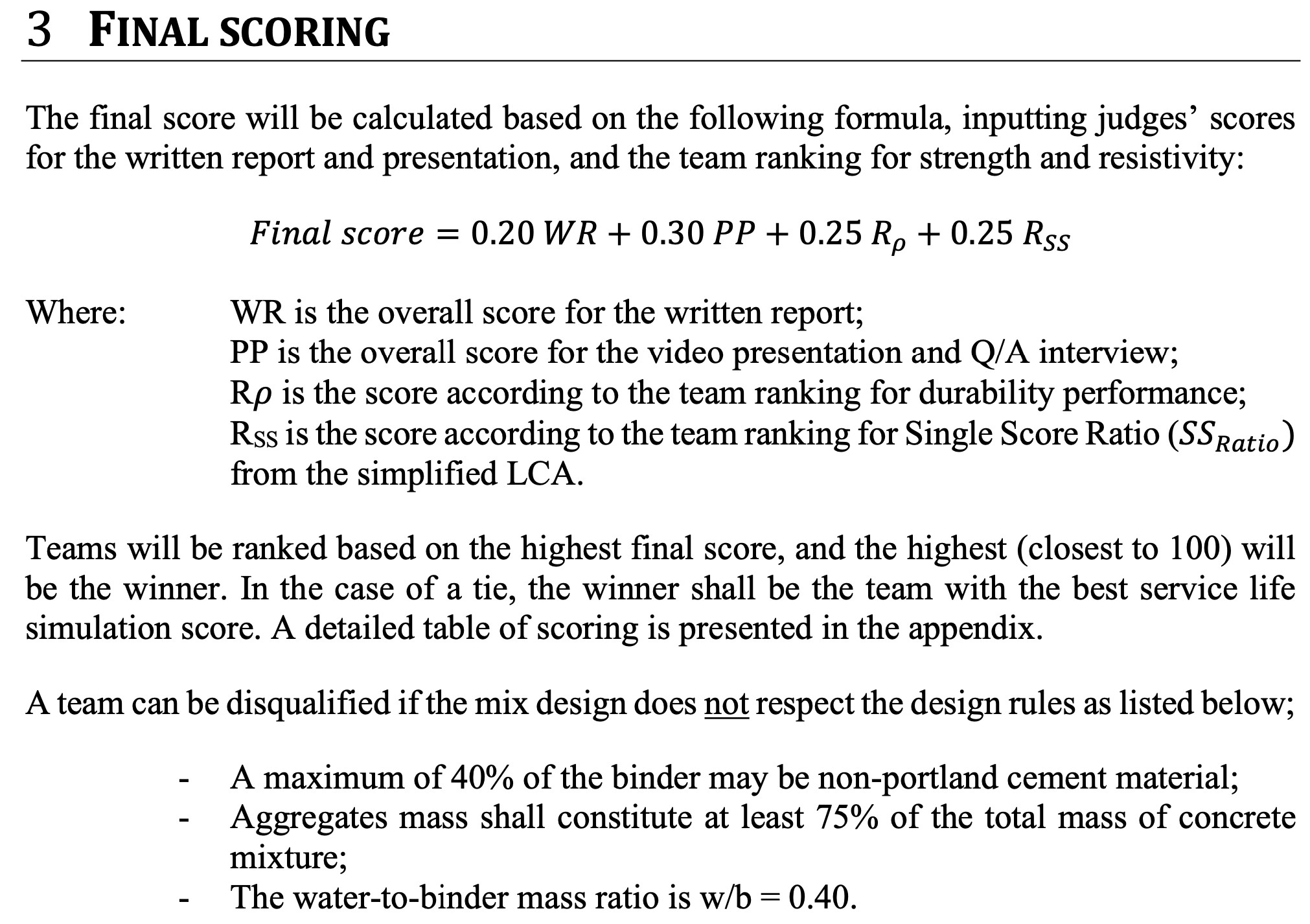
4. JUDGING
1. The judges will be appointed by ACI Iran Chapter Student Competition Committee Judges may be different for each testing category.
2. The judges will make the final determination on compliance with the rules and penalties for rules violations. Disqualified entries shall not be included in the scoring or considered for awards. All penalties will be explained fully to the teams.
3. The decision of the judges will be final, and appeals will not be considered. Suggestions for improvement may be submitted to the ACI Iran Chapter.
5. REGISTRATION AND MATERIAL SUBMISSION
a. Registration is required. Teams shall register through the competition webpage on the ACI Iran Chapter website by 5:00 p.m. on 22 November 2022. It indicates the team’s intent to enter the competition. Registration will be confirmed via email. This registration is the first of two required steps to participate in the competition.
b. The electronic report, presentation slides, video link, and JSON output file from Life 365TM as described above, shall be submitted no later than 5:00 p.m. on 6 December 2022 through the official registration process link on the ACI website. The Excel format of the EcoConcrete Calculation Tool V2.01 completed shall also be attached. The receipt of the report will be confirmed. Failure to receive confirmation indicates incomplete submission.
c. As directed on the competition webpage, Letter of Verification, remaining team members, and PowerPoint slide of the team are also required to complete the team’s submission. Details of these required items will be included on the student registration website. It is suggested to avoid waiting to the last minute for submission to avoid delays with obtaining all parts of the required documentation. Failure to provide the required documentation will disqualify a team from participating. Late entries will be penalized, up to and including possible disqualification from the competition.
d. Top 20 teams based on the best-aggregated scores of service life, LCA, written report, and video recording will be invited for an interview with the judges approximately two weeks prior to the convention date.
6. COMPLIANCE WITH ACI ECOCONCRETE COMPETITION RULES
ACI reserves the right to perform detailed examination and check entries for compliance with the competition rules. Due to the complexity of this task, the examination may be done after the competition. If the examination shows that a team did not follow the rules, the team, their advisor and all his/her teams will be disqualified. The ACI Iran Chapter competition committee will further document recommendations to sanction the team and its advisor and/or the school/university’s participation in future competitions. Failure to supply the required submittals or failure to meet the established deadlines may result in penalties, up to and including disqualification.
7. CONTACT INFORMATION
American Concrete Institute – Iran Chapter
Unit 1, No.1, Layli St.,Vanak Ave., Vanak Sq., Tehran, Iran
Phone +9821 88664151 +9821 88664152
E-mail: Convention@aciiranchapter.org
______________
Attachment A:
Eligibility Rules
www.aciiranchapter.org www.ConREC.ac.ir
مسابقه بتن سازگار با محیط زیست که توسط انجمن بین المللی بتن (ACI) – شاخه ایران برگزار خواهد شد با رویکرد نوین منطبق بر دوام بتن و تاثیرات طراح اختلاط بتن بر روی جنبه های محیط زیستی بنا شده است.
هدف:
برای مشارکت و آموزش نسل آینده مهندسان رشته عمران، معماری وسایر رشته های فنی و مهندسی در زمینه توسعه پایدار بتن، این مسابقه ملی دانشجویی جدید با هدف ترویج ایده عملکرد محیط زیستی در طرح اختلاط بتن در سال ۱۴۰۰ توسط انجمن بین المللی بتن (ACI) بوجود آمده است.
بنابراین تیم های شرکت کننده یک ماموریت دارند که یک طرح اختلاط بتن نوآورانه طراحی نمایند که پایین ترین تاثیر محیط زیستی را داشته باشد در حالی که عملکرد دوامی بتن حفظ یا ارتقاء یابد. برای دستیابی به این هدف تیم های شرکت کننده در مسابقه تشویق می شوند تا جستجو کنند و از منابع محلی مصالح دوستار محیط زیست مانند مواد جایگزین کننده سیمان (SCMs) در طرح های خود استفاده نمایند.
پس از طراحی طرح اختلاط بتن، از تیم ها خواسته می شود تا یک ارزیابی چرخه حیات (LCA) انجام دهند و نتایج خود را در قالب یک گزارش کتبی و یک ویدئو کلیپ ضبط شده (حد اکثر ۷ دقیقه) ارایه دهند. فرمت این گزارش الهام گرفته از یک سند اعلامیه محصول محیط زیستی است که مورد علاقه صنعت می باشد تا بین ردپای محیط زیستی محصولات ارتباط برقرار نماید.
علاوه بر این گزارش، تیم های می بایست نتایج شبیه سازی شده طرح اختلاط های بتن خود را توسط نرم افزار Life 365 آماده نمایند. این ابزار منبع باز توسط بسیاری از طراح های بتن و مهندس ها امروزه استفاده می شود تا بتوانند عملکرد دوامی بتن را در مقابل حمله های کلرید و نمک های آسیب رسان تخمین بزنند. در این مسابقه لازم است فیلم ضبط شده ای که خصوص طرح اختلاط بتن به داوران ارایه می شود با تاکید بر روی جنبه محیط زیستی و تاثیر آن در تصمیم گیری های دانشجویان تهیه شده باشد.
1- قوانین مسابقه:
تیم های شرکت کننده در مسابقه:
1-1 اعضاي تيم ها، دانش آموزان دبيرستانها، هنرجويان هنرستانهاي فني و حرفه اي، دانشجويان دانشگاه های سراسری، آزاد و موسسات آمورش عالی(مقطع کارشناسی و کارشناسی ارشد مهندسی عمران، معماری، مکانیک، معدن، مهندسی شیمی و… در تمامی گرایش ها)، مراکز آموزش عالي، مراكز تحقيقاتي پژوهشي دولتي و غير دولتي می باشند. لازم به ذکر است تعداد تیم های شرکت کننده از هر دانشگاه، موسسه آموزش عالی، دبیرستان، هنرستان و … نامحدود و در هر گرایش می توانند حداکثر دو تیم داشته باشند که باید اعضای تیم ها متفاوت باشند.
مثال:
تیم A از دانشگاه A جهت مسابقه Epd و Cube (استاد راهنما:A و اعضای گروه: 1و 2 و 3 و 4 و 5 و 6 و 7 و 8)
تیم B از دانشگاه A جهت مسابقه Epd و Cube (استاد راهنما:A و اعضای گروه: 9 و 10 و 11 و 12 و 13 و 14 و 15 و 16)
تیم C از دانشگاه A جهت مسابقه Bowling و پل کاغذی (استاد راهنما:B و اعضای گروه: 17 و 18 و 19و 20 و 21 و 22 و 23 و 24)
توجه: تیم C از دانشگاه A اجازه شرکت در مسابقات Cube و Epd را نخواهد داشت.
2-1 شرایط مذکور (بند 1-1) برای تمامی مسابقات غیر از مسابقه کانو بتنی(قایق بتنی) صادق می باشد.
3-1 چنانچه تعداد تیم های شرکت کننده در هر گرایش به حداقل ۴ تیم برسد مسابقه برگزار می شود در غیر اینصورت مسابقه آن گرایش برگزار نخواهد شد و نمونه تحویل گرفته شده به تیم های ثبت نام کننده عودت داده نمی شود.
4-1 هرتیم شامل حداقل ۲ نفر و حداکثر ۸ نفر عضو به همراه ۱ نفر استاد راهنما از همان موسسه آموزش عالی، دبیرستان، هنرستان و … می باشد. همه اعضای تیم باید از یک مقطع تحصیلی باشند.
5-1 هر شخص تنها مي تواند در يك تیم عضويت داشته و تیم شرکت کننده می باید معرفی نامه مهمور به مهر از موسسه آموزش عالی، دبیرستان، هنرستان و… معرفی شده را ارائه دهد.
6-1 هر موسسه آموزش عالی، دبیرستان، هنرستان و… برنده حداکثر یک رتبه (مقام) خواهد بود.
7-1 استاد راهنما فقط مسئوليت هدايت اعضاي تيم و رعايت قوانين مسابقه از طرف تيم را بر عهده دارد.
8-1 هر استاد راهنما نمي تواند سرپرستي بیش از دو تیم از یک دبیرستان، هنرستان، موسسه آموزش عالی و … بر عهده بگيرد.
9-1 فرم های ثبت نام از طریق ایمیل یا فکس می بایست ارسال شود. شرکت کنندگان فرم ثبت نام را می بایست از وب سایت aciiranchpter.org دانلود و تکمیل نموده، به همراه مدارک خواسته شده شامل(معرفی نامه برروی سربرگ دانشگاه یا گواهی اشتغال به تحصیل، کپی کارت دانشجویی معتبر، کپی کارت ملی، فیش واریزی ثبت نام) به دبیرخانه همایش از طریق ایمیل به آدرس convention@aciiranchapter.org و یا از طریق فکس به شماره 88797454 ارسال نمایند.
10-1 آخرین مهلت ثبت نام برای شرکت در مسابقه بتن سازگار با محیط زیست، ساعت ۱۷:۰۰ روز جمعه مورخ 24 آذر ماه ۱۴۰2 می باشد.
11-1 تاریخ برگزاری مصاحبه آنلاین مسابقه بتن سازگار با محیط زیست:
مصاحبه آنلاین مسابقه بتن سازگار با محیط زیست روز پنجشنبه مورخ 30 آذر ماه سال ۱۴۰2 می باشد.
12-1 تاریخ تحویل مدارک:
شرکت کنندگان می بایست یک نسخه گزارش چاپ شده (Hard copy)، CD گزارش و فیلم خود را طبق فرمت آورده شده در بخش ۲.۶ و ۲.۷ آیین نامه به همراه اصل مدارک (شامل اصل فرم ثبت نام و معرفی نامه برروی سربرگ دانشگاه یا گواهی اشتغال به تحصیل) را به صورت حضوری در روز اول همایش روز سه شنبه مورخ 5 دی ساعت 8:00 صبح به محل دریافت نمونه های دانشجویی ارایه نمایند.
تحویل مدارک توسط یک نفر (سرپرست و یا نماینده تیم) انجام می شود.
13-1 هزینه واریزی جهت ثبت نام به هیچ عنوان عودت داده نمی شود.
14-1 استاد راهنما باید از اعضای هیات علمی و یا مدرسین دانشگاه تیم دانشجویی مربوطه باشد.
- حضور استاد راهنما در روز مسابقه و زمان برگزاری مسابقه تیم خود الزامی است و عدم حضور باعث حذف تیم دانشجویی می شود.
- همراه داشتن معرفی نامه از دانشگاه و اصل کارت دانشجویی در روز همایش الزامی است.
15-1 گزیده هایی از مسابقات ملی بتن مورخ 5 و 6 دی ماه سال ۱۴۰2 به صورت زنده (Live) از وب سایت مرکز تحقیقات بتن www.ConREC.ac.ir پخش می شود. جهت اطلاع از جزئیات پخش مسابقات بتن به وب سایت مراجعه نمایید.
16-1 نتایج بیست و ششمین دوره مسابقات دانشجویی ملی بتن، مورخ 6 دی ماه سال ۱۴۰2 در مراسم اختتامیه جشنواره و کنفرانس بتن و زلزله مرکز تحقیقات بتن (متب) اعلام می شود.
قابل توجه شرکت کنندگان بیست و ششمین دوره مسابقات سالیانه ملی دانشجویی انجمن علمی بین المللی بتن آمریکا (ACI)- شاخه ایران:

قابل توجه کلیه دانشجویان و شرکت کنندگان در بیست و ششمین همایش ملی سالیانه بتن و زلزله:
همایش ملی سالیانه بتن و زلزله و آیین نامه مسابقات دانشجویی مرکز تحقیقات بتن (متب) طبق مصوبه وزارت علوم، تحقیقات و فناوری متعلق و خاص این مرکز بوده و استفاده از آنها خارج از مسابقات فوق پیگرد قانونی خواهد داشت.

